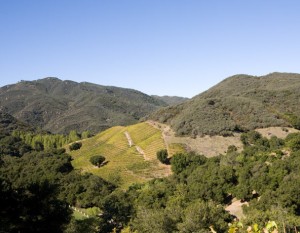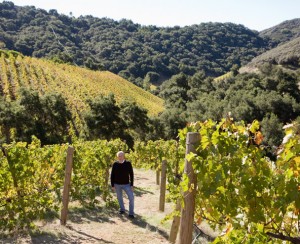 “If anybody said this was Malibu, you’d say they were crazy,” says Richard Hirsh, the millionaire clothier-turned-vintner standing in the vineyards of his Cielo Farms estate.
“If anybody said this was Malibu, you’d say they were crazy,” says Richard Hirsh, the millionaire clothier-turned-vintner standing in the vineyards of his Cielo Farms estate.
Hidden in these canyons are not only A-list movie stars like Jennifer Aniston and Mel Gibson but also more than 40 vineyards. They range from postage-stamp-size plots to serious commercial enterprises run by unlikely but dedicated gentleman farmers: wealthy entrepreneurs, developers and restaurateurs who can afford to grow grapes and make wine on some of the most expensive real estate in America.
“Malibu isn’t a farming community,” says Tim Skogstrom, who recently opened the Cornell Winery and Tasting Room nearby in the Santa Monica Mountains.

Still, wine isn’t new to the area. In the mid-1800s, Los Angeles County was the center of the California wine world; by 1870, the region’s 43 wineries were producing four million gallons of wine. Rapid urban growth, Prohibition, an epidemic of a vine-killing disease, and the rise of Napa and Sonoma in the North, however, soon wiped out the industry here. Now, a century later, wine is making a comeback, with a clutch of tasting rooms sprouting up along the canyon roads.
It is doing so with people like George Rosenthal, a movie studio magnate-turned vintner who cultivates 30 acres of vines at his hacienda-style country house. (His full-time residence is in Santa Monica.) Rosenthal was one of the first to reintroduce grapes to Malibu, planting a few acres of Bordeaux varietals in 1987. Now in his 70s, he zips through his estate on an electric golf cart, pointing out the challenges of his site, which are typical in Malibu. There are no valley vineyards here, but rather mountainous terrain with an array of soils, microclimates and sun exposures — so every block within a site requires a high level of care.

Rosenthal Estate wines, which are sold at iconic restaurants like the Polo Lounge at the Beverly Hills Hotel, are still not turning a profit — even 22 years in. This is not uncommon because of the high overhead (water is scarce and extremely expensive statewide, and most of the vineyards have to be worked by hand because the slopes won’t accommodate machinery. But profit isn’t the point; everyone making wine in Malibu can afford to lavish money on the project. “It’s about the passion,” Rosenthal says. “There’s a great romance to a vineyard and sharing that lifestyle with others.”
One man who may break that mold is Charles Schetter, whose Malibu Sanity label, Skogstrom predicts, will be “the first cult wine out of the area.” A large-scale land developer by day, and a longtime Burgundy collector, Schetter planted six blocks of chardonnay and pinot noir in 2005, in his backyard, which happens to have the ideal microclimate: cool coastal breezes and lots of afternoon sunshine. His obsessive personality helps, too: Schetter tends the vines himself, has attended enology classes and constantly checks the computerized weather monitor that he keeps by his bed. “If you’re going to be serious about winemaking, you need to go all the way,” he says. “Short of that, it’s a hobby —or you’re just writing the checks.”
The region is still evolving, but across the board, the quality of Malibu vintages is improving. Alex Weil, the head sommelier at the new Bouchon restaurant in Beverly Hills, has watched the region advance over the past 15 years and thinks it holds promise. “They’ve got terroir and a coastal climate, like Rhone or Burgundy, and a population with the means to keep experimenting and learning,” he says. But to get respect in the wine world, “they’ll need to produce a truly great wine, or have a great figure, a star, emerge from the pack. That will take time, no question.”
Most locals acknowledge as much. “We’re where Santa Ynez was 20 years ago,” says Tony Griffin, screenwriter and scion of the Merv Griffin entertainment empire — and since 1998, a grower of chardonnay and malbec in a half-acre backyard plot he calls the Griffin Family Vineyard. He points to his Burgundian-style chardonnay — “see, the label’s crooked because I put it on myself.” He takes a swig and adds: “The thing Malibu needs is age, to age like a good wine. In 10, 15 years, we’ll be good. Right now, we’re just baby wines.”
ESSENTIALS
The best Malibu wines are sold at Malibu Village Wines (3900 Cross Creek Road, 310-456-2924, www.malibuvillagewines.com) and Cornell Winery and Tasting Room (29975 Mulholland Highway, 818-735-3542, www.cornellwinery.com). Or piece together your own Malibu wine-tasting trail at the Rosenthal Estate Wines Tasting Room (26023 Pacific Coast Highway, 310-456-1392, www.rosenthalestatewines.com), Malibu Wines (Semler and Saddlerock’s tasting room) (31800 Mulholland Highway, 818-865-0605,www.malibuwine.com), and SIP Malibu (Cielo’s tasting room) (2598 Sierra Creek Road, 818-865-0440, www.cielofarms.com).
Six wines worth seeking out:
- 2007 Hoyt Family Vineyards Chardonnay, $26 Big and buttery, but well balanced, from one of the region’s only female wine producers.
- 2007 Malibu Vineyards Cabernet Franc, $32 Double gold medal winner at the San Francisco International Wine Competition, made by an unusually hands-on proprietor.
- 2008 Malibu Sanity Pinot Noir, $46 Malibu’s best pinot, from one of the region’s most promising boutique vineyards.
- 2008 Griffin Family Vineyard Chardonnay, $46 Bright and tropical, with great acidity.
- 2005 Rosenthal Estate Wines Block M Single-Vineyard Cabernet Sauvignon, $50 The latest release from one of Malibu’s wine pioneers, known for their muscular cabs.
- 2007 Semler Sauvignon Blanc, $23 Restrained, mineral-laden, Italian-style, pairs well with food.
